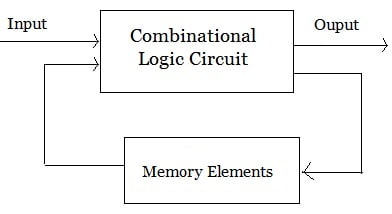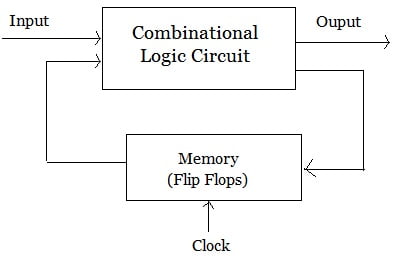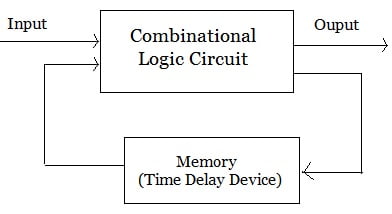This post related to the difference between synchronous and asynchronous sequential circuits in table form. Before the differences look at the basic definitions and block diagrams of the sequential circuits and their types.
Table of Contents
Sequential Circuits
Sequential circuit is a combination of a combinational circuit and a memory elements connected in feedback path. The memory elements are devices capable of storing binary information within them.The binary information stored in the memory elements at any given time defines the state of the sequential circuit. The sequential circuit receives binary information from external inputs. Thus, a sequential circuit is specified by a time sequence by a time sequence of inputs, outputs and internal states.
A block diagram of sequential circuit is shown in figure below.

Types of Sequential Circuits
There are two types of sequential circuits:
- Synchronous sequential circuit
- Asynchronous sequential circuit
Synchronous sequential circuit
A sequential circuit whose output behavior depends on the input at a discrete-time is called synchronous sequential circuits. Synchronous sequential circuits that use clock pulses in the inputs of memory elements are called clocked sequential circuits.

Asynchronous sequential circuit
The sequential circuit whose output depends on the sequence in which the input changes are called asynchronous sequential circuits.

Difference between Synchronous and Asynchronous sequential circuits
| S. No. | Synchronous sequential circuit | Asynchronous sequential circuit |
| 1 | Synchronous sequential circuits are digital circuits governed by clock signals. | Asynchronous sequential circuits are digital circuits that are not driven by clock. They can be called as self-timed circuits. |
| 2 | Output behavior depends on the input at discrete time. | Output depends on the sequence in which the input changes. |
| 3 | In synchronous sequential circuits inputs and outputs are considered at discrete time instants. | In asynchronous sequential circuits input and output signals are defined at every value of time. |
| 4 | In synchronous sequential circuits memory elements are used like clocked flip flop. | In asynchronous sequential circuits un-clocked memory elements are used like un-clocked flip flop or time delay elements. |
| 5 | The time variable is discrete. | The time variable is continuous. |
| 6 | Synchronous sequential circuits are easier to describe, analyze and design. | Asynchronous sequential circuits are more difficult to describe, analyze and design. |
| 7 | Due to the presence of clock pulse the operating speed of synchronous sequential circuits is low. | Because of absence of clock pulse, it can be operate faster than Synchronous sequential circuits |
| 8 | In these circuits change in state occurs in response to clock pulse. | In these circuits state change occurs whenever input variable change. |
| 9 | In synchronous circuits no timing problem in feedback path. | In asynchronous circuits timing problem involved in feedback path. |
| 10 | These are more expensive. | These are economical. |
| 11 | It has complex circuitry. | It has few components. |
| 12 | Any number of inputs can change simultaneously (during the absence of clock). | Only one input is allowed to change at a time in the case of level inputs and only one pulse input is allowed to be present in the case of the pulse input. |
| 13 | Synchronous circuits are used in counters, shift registers, memory units. | On the other hand, Asynchronous circuits are used in low power and high-speed operations such as simple microprocessors, digital signal processing units, and in communication systems for email applications, internet access, and networking. |


